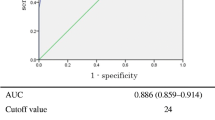Abstract
Background
Currently, no validated German-language self-report screening instrument exists for the assessment of sleep disorders in childhood.
Objective
To translate the Children’s Sleep Habits Questionnaire (CSHQ-DE) into German and validate the German version.
Material and methods
Based on a community sample of 298 parents of healthy children between 4 and 10 years of age and parents of a clinical sample of children (n=45) with sleep disorders, the factor structure and psychometric properties of the German translation were analyzed.
Results
All factors of the English version, including bedtime resistance, sleep-onset delay, sleep duration, sleep anxiety, night waking, sleep-disordered breathing, and parasomnias, were verified. Internal consistency was α=0.68; retest–reliability was r=0.76.
Conclusion
The German version of the CSHQ can be used as a validated screening instrument to identify sleep-related disorders in children.
Zusammenfassung
Hintergrund
Zur elterlichen Erfassung von Schlafstörungen im Kindesalter steht gegenwärtig im deutschsprachigen Raum kein evaluiertes Screeninginstrument zur Verfügung.
Ziel
Eine deutschsprachige Version des Children’s Sleep Habits Questionnaire (CSHQ-DE) wurde erstellt und validiert.
Material und Methoden
Anhand einer Normstichprobe, bestehend aus 298 Eltern von Kindern zwischen 4 und 10 Jahren, sowie Eltern von Kindern mit einer Schlafstörung (n=45) wurde die deutsche Übersetzung des CSHQ-DE auf ihre Faktorenstruktur und ihre psychometrischen Eigenschaften überprüft.
Ergebnisse
Die Subskalen des englischsprachigen CSHQ-DE „bedtime resistance“, „sleep-onset delay“, sleep duration“, „sleep anxiety“, „night waking“, „sleep-disordered breathing“ und „parasomnias“ konnten bestätigt werden. Die interne Konsistenz liegt bei α=0,68, die Retestreliabilität bei r=0,76.
Fazit
Die deutsche Version des CSHQ kann als validiertes Screeninginstrument zur Erkennung von Schlafstörungen im Kindesalter anhand des Elternurteils eingesetzt werden.
Similar content being viewed by others
References
AASM (2005) International classification of sleep disorders (ICSD-2). Rochester, MN
Brislin RW (1970) Back-translation for cross-cultural research. J Cross Cult Psychol 1(3):185–216
Brislin RW (1986) The wording and translation of research instrument. In: Lonner WJ, Berry JW (eds) Field methods in cross-cultural research. Sage, Beverly Hills, CA, pp 137–164
Bruni O, Ottaviano S, Guidetti V et al (1996) The sleep Disturbances Scale for Children (SDSC). Construction and Validation of an Instrument to Evaluate Sleep Disturbances in Childhood and Adolescence. J Sleep Res 5:251–261
Chang AM, Chau JP, Holroyd E (1999) Translation of questionnaires and issues of equivalence. J Adv Nurs 29(2):316–322
Cook J, Burd L (1990) Preliminary report on construction and validation of pediatric sleep disturbance questionnaire. Percept Mot Skills 70(1):259–267
Faust V, Hole G (1991) Der gestörte Schlaf und seine Behandlung. University of Ulm, Ulm
Field A (2005) Discovering Statistics using SPSS. SAGE Publications, London
Iglowstein I, Jenni OG, Molinari L et al (2003) Sleep duration from infancy to adolescence: reference values and generational trends. Pediatrics 111:302–307
Jones PS, Lee WJ, Phillips LR et al (2001) An adaption of Brislin’s translation model for cross-cultural research. Nurs Res 50(5):300–304
Kahn A, Van de Merckt C, Rebuffat E et al (1989) Sleep problems in healthy preadolescents. Pediatrics 84(3):542–546
Kraenz S, Fricke L, Wiater A et al (2003) Schlafprobleme bei Schulanfängern. Erste Ergebnisse der Studie “Gesunder Schlaf für Kölner Kinder”. Kinder- und Jugendarzt 34:562–569
Mindell JA (1993) Sleep disorders in children. Health Psychol 12:151–162
Mindell JA, Moline ML, Zendell SM et al (1994) Pediatricians and sleep disorders: training and practice. Pediatrics 94(2 Pt 1):194–200
Owens JA, Spirito A, McGuinn M (2000) The Children’s Sleep Habits Questionnaire (CSHQ): psychometric properties of a survey instrument for school-aged children. Sleep 23(8):1043–1051
Paavonen EJ, Aronen ET, Moilanen I et al (2000) Sleep problems of school-aged children: a complementary view. Acta Paediatr 89(2):223–228
Rona RJ, Li L, Gulliford MC, Chinn S (1998) Disturbed sleep: effects of sociocultural factors and illness. Arch Dis Child 78(1):20–25
Schlarb AA (2010) Das KiSS-Therapiekonzept. Kohlhammer, Stuttgart (in press)
Conflict of interests
The corresponding author states that there are no conflicts of interest.
Author information
Authors and Affiliations
Corresponding author
Rights and permissions
About this article
Cite this article
Schlarb, A., Schwerdtle, B. & Hautzinger, M. Validation and psychometric properties of the German version of the Children’s Sleep Habits Questionnaire (CSHQ-DE). Somnologie 14, 260–266 (2010). https://doi.org/10.1007/s11818-010-0495-4
Published:
Issue Date:
DOI: https://doi.org/10.1007/s11818-010-0495-4



